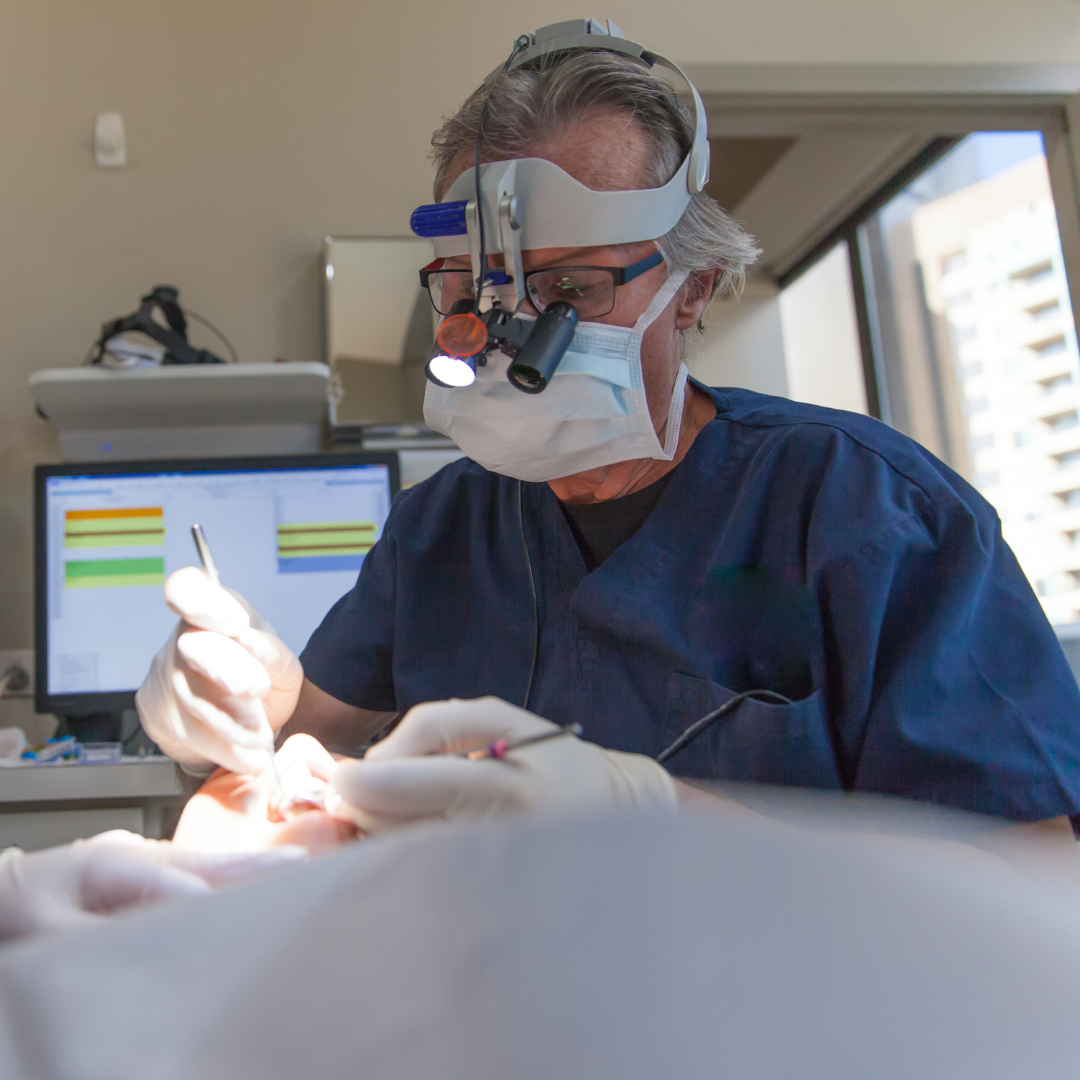When it comes to oral surgery, anesthesia can be a concern, but understanding the facts can put even the most apprehensive patient at ease.
As experts in oral and maxillofacial surgery, we understand that undergoing any type of procedure can be stressful for patients, especially when it involves anesthesia. We want to assure you that your safety and comfort are our highest priorities.
"There are many types of anesthesia, and your surgeon will review your medical history and the procedure to help determine the best options available for your case," says Dr. David J. Hoffman, DDS, MD of Northwest Oral & Maxillofacial Surgery.
Oral and maxillofacial surgeons are extensively trained to administer local anesthesia, all forms of sedation and general anesthesia in a safe and cost-effective manner in the office setting.
The American Association of Oral and Maxillofacial Surgeons (AAOMS) ensures that oral and maxillofacial surgeons obtain continuing education in anesthesia and regularly undergo a rigorous office anesthesia evaluation and certification.
“From the earliest days of the specialty, there has been an emphasis on outpatient anesthesia education, with ongoing updates to formal training requirements aimed at improving patient safety,” says an AAOMS white paper.
Three Main Categories of Anesthesia
The three main categories of anesthesia used in oral and maxillofacial surgery are local anesthesia, minimal/moderate sedation, and deep sedation/general anesthesia. Here's an overview of each:
Local Anesthesia
Local anesthesia numbs a specific area, such as part of the mouth or jaw. It is typically injected and blocks nerve signals to prevent pain while you remain fully conscious. Local is used for simpler procedures like tooth extractions.
Minimal & Moderate Sedation
Minimal sedation, sometimes called anxiolysis, is a drug-induced state where you respond normally to verbal commands. Cognitive function and coordination may be impaired but breathing and heart function remain unaffected. It's often used for dental implant placement or bone grafting procedures.
Moderate sedation is a deeper drug-induced depression of consciousness. You can still purposefully respond to verbal commands but may need light physical stimulation. Breathing slows but remains adequate and cardiovascular function is usually maintained. It's often used for more involved procedures like multiple tooth extractions.
Minimal and moderate sedation can be administered orally (in pill form), through inhalation of nitrous oxide gas, or intravenously.
Deep Sedation & General Anesthesia
Under deep sedation, you cannot easily be roused but may respond to repeated or painful stimulation.
With general anesthesia, you are completely unconscious and cannot be awakened even with painful stimuli.
Deep sedation and general anesthesia are administered intravenously and/or by inhalation. They are used for the most complex oral and maxillofacial surgeries.
“Remember, all patients are not the same. The surgeons at Northwest Oral & Maxillofacial Surgery will perform a thorough history and physical exam and determine which is the best anesthesia option for each individual patient,” said Dr. Hoffman.
Anesthesia Delivery Techniques
Various techniques are used to deliver anesthesia depending on the type of anesthesia, the procedure, and patient factors. These include:
- Inhalation: Breathing in an anesthetic gas, like nitrous oxide, through a mask.
- Intravenous (IV): Injecting anesthetic drugs into a vein.
- Intramuscular (IM): Injecting medication into a muscle, often used for premedication before IV access.
- Oral: Taking a pill or liquid medication by mouth.
- Local Infiltration: Injecting numbing medication near the surgical site.
- Nerve blocks: Injecting numbing medication near a cluster of nerves to numb a larger area.
Therapeutic Goals and Outcomes of Anesthesia
The primary goal of anesthesia is to keep you safe and comfortable during your procedure. Specific aims include:
- Analgesia: Relieving pain and discomfort.
- Amnesia: Preventing memory formation of the procedure.
- Immobility: Keeping you still to optimize surgical conditions.
- Unconsciousness: Rendering you unaware during general anesthesia.
- Maintenance of vital functions: Ensuring your safety and well-being by monitoring and maintaining your vital functions such as heart rate, blood pressure, and body temperature.
Ultimately, successful anesthesia allows your surgeon to focus on performing the procedure effectively while you remain oblivious to the process.
“The therapeutic goals for office-based anesthesia revolve around the management of anxiety, fear, and pain,” explains AAOMS. “Most patients have such concerns about their proposed surgical treatment. The selection of the best technique for controlling anxiety, fear, and pain for a specific patient and procedure must be determined by the surgeon based on training, experience, and an understanding of risks and benefits.”
OMS Team Model of Anesthesia Delivery
In the oral and maxillofacial surgery office setting, anesthesia is typically delivered using a team model. The surgeon conducts the surgery and directs the anesthesia while trained assistants continually monitor the patient.
This team approach has several advantages:
- The surgeon has intimate knowledge of both the patient's medical history and the intricacies of the surgical procedure.
- There is seamless coordination between the delivery of anesthesia and the stages of surgery.
- Any changes in the patient's condition are promptly recognized and addressed.
- The surgical team is attuned to each patient's unique needs from start to finish.
Numerous studies have confirmed the safety and efficacy of this time-tested model in the OMS office setting, which has now been in widespread use for more than 50 years.
Patient Evaluation
Every patient is unique, and anesthesia must be tailored to individual needs and circumstances. Factors we consider include:
- Age: Pediatric and geriatric patients require special anesthesia considerations and monitoring for safety.
- Pregnancy: Pregnant women, especially those in the third trimester, are at higher risk for anesthesia complications. Special precautions are taken.
- Obesity: Obese patients are more prone to breathing problems under anesthesia. Positioning and medication dosing also require adjustments.
- Medical Conditions: Conditions like asthma, sleep apnea, heart disease, high blood pressure, and diabetes can increase anesthesia risks. These are carefully evaluated and managed.
- Medications: Some drugs can interact with anesthesia. All current medications, including supplements, are reviewed.
- Allergies: Medication allergies are assessed to avoid potentially serious reactions.
- Previous Anesthesia Experiences: Any prior issues with anesthesia are important to disclose.
A thorough preoperative evaluation, including a detailed medical history, physical exam, and any necessary testing, is conducted to develop a personalized anesthesia plan for each patient.
Risks & Complications
As with any medical procedure, anesthesia does involve some risks, even in healthy patients.
Common side effects may include nausea, vomiting, dry mouth, sore throat, shivering, sleepiness, and mild hoarseness.
During your consultation, your doctor will also go over more serious but rare complications that can also occur.
Extensive Training to Minimize Risks
To minimize risks, oral and maxillofacial surgeons undergo rigorous training and education.
“Oral and maxillofacial surgeons (OMSs) are trained in all aspects of anesthesia administration,” says AAOMS.
After completing dental school, they spend an additional 4-6 years training alongside medical residents in a hospital-based residency.
This includes a minimum of 4 months dedicated to anesthesia where they perform general anesthetics and intubating patients while learning how to evaluate patients for anesthesia, deliver the anesthetic, and monitor patients during and after.
OMSs in their last year of training also perform outpatient anesthesia for the oral surgical procedures in their clinic – this can range from local anesthesia to deep sedation.
“As a result of extensive training, every oral and maxillofacial surgeon is well-prepared to appropriately administer local anesthesia, and all forms of sedation including general anesthesia,” says AAOMS. “Your OMS is experienced in airway management, endotracheal intubation, establishing and maintaining intravenous lines as well as managing complications and emergencies that may arise during the administration of anesthesia.”
Additionally, oral surgeons are trained in emergency management, including the handling of complications related to anesthesia. Many complete Advanced Cardiac Life Support certification.
“All surgeons at Northwest Oral & Maxillofacial Surgery are certified to provide anesthesia, not only to healthy patients, but to high-risk and pediatric patients, which are separate permits given by the Texas Medical Board,” said Dr. Hoffman.
Our Commitment to Patient Safety
At Northwest Oral & Maxillofacial Surgery, we have assembled a team of exceptionally well-trained and highly skilled surgeons and support staff. Some of the ways we ensure patient safety include:
- Thoroughly reviewing medical history and carefully determining the most appropriate anesthesia approach for each patient and procedure.
- Using state-of-the-art monitoring equipment to continually assess breathing, oxygenation, circulation, and temperature.
- Regularly conducting emergency drills and simulations so our entire team is prepared to handle any situation.
- Staying up to date on the latest anesthesia research, techniques, and technologies through ongoing education and training.
Have Additional Questions About Anesthesia?
We hope this overview has helped ease any concerns you may have about anesthesia for your upcoming oral surgery procedure.
If you have additional questions, please don't hesitate to reach out to us at Northwest Oral & Maxillofacial Surgery. We're here to provide all the information you need to feel safe, comfortable, and confident going into treatment.
Contact us today to speak with one of our knowledgeable team members.







